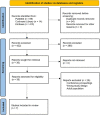Heparin-based versus bivalirudin-based anticoagulation in pediatric extracorporeal membrane oxygenation: A systematic review
- PMID: 36999064
- PMCID: PMC10043325
- DOI: 10.3389/fmed.2023.1137134
Heparin-based versus bivalirudin-based anticoagulation in pediatric extracorporeal membrane oxygenation: A systematic review
Abstract
Introduction: Optimal anticoagulation therapy is essential for the prevention of thrombotic and hemorrhagic complications in pediatric patients supported with extracorporeal membrane oxygenation (ECMO). Recent data have demonstrated bivalirudin has the potential to surpass and replace heparin as the anticoagulant of choice.
Methods: We conducted a systematic review comparing the outcomes of heparin-based versus bivalirudin-based anticoagulation in pediatric patients supported on ECMO to identify the preferred anticoagulant to minimize bleeding events, thrombotic complications, and associated mortality. We referenced the PubMed, Cochrane Library, and Embase databases. These databases were searched from inception through October 2022. Our initial search identified 422 studies. All records were screened by two independent reviewers using the Covidence software for adherence to our inclusion criteria, and seven retrospective cohort studies were identified as appropriate for inclusion.
Results: In total, 196 pediatric patients were anticoagulated with heparin and 117 were anticoagulated with bivalirudin while on ECMO. Across the included studies, it was found that for patients treated with bivalirudin, trends were noted toward lower rates of bleeding, transfusion requirements, and thrombosis with no difference in mortality. Overall costs associated with bivalirudin therapy were lower. Time to therapeutic anticoagulation varied between studies though institutions had different anticoagulation targets.
Conclusion: Bivalirudin may be a safe, cost-effective alternative to heparin in achieving anticoagulation in pediatric ECMO patients. Prospective multicenter studies and randomized control trials with standard anticoagulation targets are needed to accurately compare outcomes associated with heparin versus bivalirudin in pediatric ECMO patients.
Keywords: anticoagulation; bivalirudin; direct thrombin inhibitor; extracorporeal membrane oxygenation (ECMO); pediatric.
Copyright © 2023 Valdes, Sharaf, Bleiweis, Jacobs, Mumtaz, Sharaf, Jeng and Peek.
Conflict of interest statement
The authors declare that the research was conducted in the absence of any commercial or financial relationships that could be construed as a potential conflict of interest.
Figures
References
-
- Andrew M, Paes B, Milner R, Johnston M, Mitchell L, Tollefsen D, et al. Development of the human coagulation system in the full-term infant. Blood. (1987) 70:165–72. - PubMed
Publication types
LinkOut - more resources
Full Text Sources


